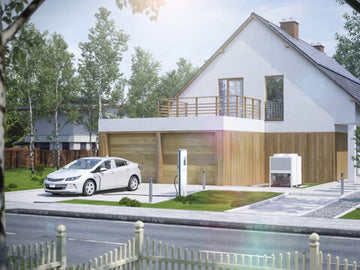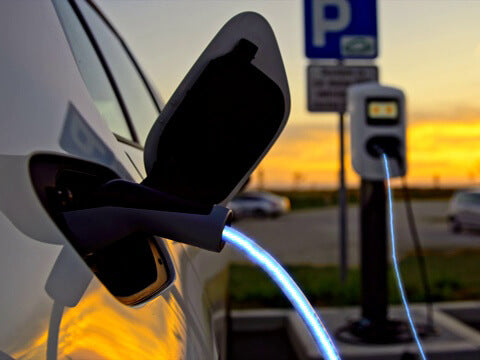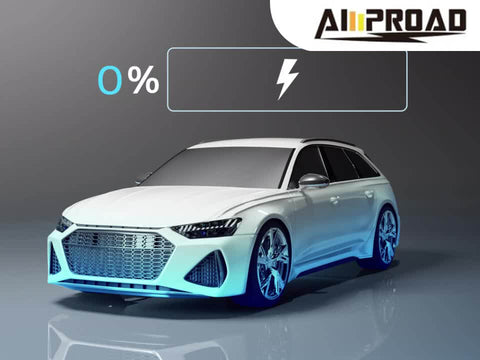
Type 1 and Type 2 EV chargers stand as two prominent standards, each with distinct features and applications. Type 1 chargers, prevalent in North America and Japan, sport a pistol-shaped connector and are known for their historical significance in early EV models. Conversely, Type 2 chargers, widely adopted in Europe and beyond, boast a round, seven-pin design, offering versatility and compatibility with various EV models and charging networks. Delving into these differences sheds light on crucial factors such as charging speed, regional adoption, and compatibility considerations. By unraveling the contrast between Type 1 and Type 2 EV chargers, this article aims to empower EV owners with insights for informed decision-making and enhanced electric mobility experiences.
What Are Type 1 EV Chargers?
Description and Specifications
Type 1 EV chargers play a pivotal role in electric vehicle charging infrastructure, especially in regions like North America and Japan. Understanding their specifications and design elucidates their significance in the realm of electric mobility.
Detailed Examination of Connector Type and Design
Type 1 chargers typically feature a single-phase AC connector with five pins, commonly known as J1772 connectors. Their distinctive pistol-shaped design makes them easily recognizable at charging stations, facilitating compatibility with a wide range of electric vehicles.
Insights into Charging Capacity and Compatibility
Type 1 chargers usually offer lower charging capacities compared to Type 2 chargers, making them suitable for slower charging applications. Despite their slower charging speeds, they remain integral for residential, workplace, and public charging installations, catering to the diverse needs of EV owners.
Primary Applications of Type 1 Chargers
Type 1 chargers have a rich history of usage in electric vehicle charging, dating back to the early days of electric mobility. Their applications span across various sectors, contributing to the widespread adoption of electric vehicles in specific markets.
Historical Context: Their Prevalence in Early EV Models
During the nascent stages of electric vehicle development, many iconic models, such as the Nissan Leaf and Chevrolet Volt, were equipped with Type 1 connectors. This historical context underscores the pivotal role of Type 1 chargers in shaping the evolution of electric mobility.
Examination of Their Current Usage in Specific Markets
While Type 1 chargers may face declining popularity in some regions, they continue to serve as a reliable charging solution, particularly in North America and parts of Asia. Despite the emergence of alternative charging standards, their prevalence in specific markets highlights their enduring importance in supporting electric vehicle adoption and accessibility.
How Many Levels Are there for Type 1 EV Charger?
Type 1 EV chargers encompass multiple levels, with Level 1 and Level 2 EV charger being the most common. Level 1 chargers use a standard household outlet and provide slower charging, while Level 2 chargers offer faster charging rates and are commonly found in residential, workplace, and public charging installations. This multi-level approach caters to the diverse charging needs of EV owners, providing flexibility and convenience in charging options.
What Are Type 2 EV Chargers?
Description and Specifications
Type 2 EV charger represents a significant advancement in charging technology, offering enhanced versatility and compatibility compared to their Type 1 counterparts. Understanding their specifications and design illuminates their role as a cornerstone of electric vehicle charging infrastructure.
In-depth Analysis of Connector Type and Design
Type 2 connectors feature a round, seven-pin design, distinguishing them from the pistol-shaped Type 1 connectors. This design facilitates compatibility with both single-phase and three-phase AC charging, making Type 2 chargers adaptable to various charging scenarios.
Exploration of Charging Capacity and Compatibility
Type 2 chargers boast higher charging capacities compared to Type 1 chargers, making them suitable for fast and rapid charging applications. Their ability to deliver higher power levels enables EV owners to recharge their vehicles more quickly, enhancing the overall charging experience.
The Advantages and Adaptability of Type 2 Chargers
Type 2 chargers have emerged as the standard in many regions worldwide, owing to their versatility and compatibility with a wide range of electric vehicle models and charging networks.
Widespread Adoption as a Standard in Various Regions, Particularly Europe
In Europe, Type 2 chargers have become the standard for public charging infrastructure, facilitating interoperability and ease of use for EV owners. Their widespread adoption ensures consistency and reliability across charging networks, contributing to the seamless integration of electric mobility into everyday life.
Compatibility with Diverse EV Models and Charging Networks
Type 2 chargers offer broad compatibility with electric vehicles from European, American, and Asian manufacturers. This compatibility makes Type 2 chargers a preferred choice for public charging stations, ensuring accessibility for EV owners regardless of their vehicle's make or model.
Type 2 EV chargers represent a significant step forward in electric vehicle charging technology. Their versatility, higher charging capacities, and widespread adoption make them an indispensable component of charging infrastructure, driving the transition to electric mobility on a global scale.
Key Contrasts Between Type 1 and Type 2 Chargers
Distinctions in Connector Design and Compatibility
Type 1 and Type 2 chargers exhibit notable disparities in connector design and compatibility, reflecting their regional adoption patterns.
Type 1 chargers feature a specific connector design primarily utilized in North America and Japan. Recognized by their pistol-shaped J1772 connectors, Type 1 chargers are commonly found in charging stations across these regions. In contrast, Type 2 chargers boast a more versatile connector design, characterized by round, seven-pin connectors. This design, adopted as a standard in Europe and other regions, enhances compatibility with a broader range of electric vehicles, facilitating interoperability and ease of use for EV owners.
Variances in Charging Capacity and Speed
Another significant contrast between Type 1 and Type 2 chargers lies in their charging capacity and speed, influencing their suitability for various charging applications.
Type 1 chargers typically offer slower charging speeds compared to Type 2 chargers, making them ideal for overnight or slower charging scenarios. This slower charging rate aligns with their historical usage patterns and prevailing charging infrastructure in North America and Japan. In contrast, Type 2 chargers deliver faster charging speeds, catering to the increasing demand for rapid charging solutions in Europe and other regions. Their higher charging capacities enable EV owners to recharge their vehicles more quickly, facilitating shorter charging times and greater convenience.
Examination of Global Adoption Rates and Regional Disparities
The global adoption rates of Type 1 and Type 2 chargers exhibit notable regional disparities, reflecting varying preferences and regulatory frameworks across different markets.
Type 2 chargers have witnessed widespread adoption in Europe, where they serve as the standard for public charging infrastructure. Their prevalence in Europe underscores the region's commitment to electric mobility and the establishment of interoperable charging networks. Additionally, Type 2 chargers are increasingly utilized in other regions worldwide, reflecting their versatility and compatibility with a diverse range of electric vehicle models.
In contrast, Type 1 chargers remain prevalent in specific markets, particularly in North America and parts of Asia, where they were initially adopted. Despite declining popularity in some regions, Type 1 chargers continue to play a vital role in supporting electric vehicle adoption and accessibility, especially in regions with established charging infrastructure and EV ownership.
Considerations for EV Owners
Evaluating Charger Compatibility
When selecting chargers for their electric vehicles (EVs), owners must assess compatibility with their specific vehicle models. Understanding the charger type supported by their EV ensures seamless integration with the charging infrastructure. This evaluation ensures efficient charging experiences and minimizes potential compatibility issues.
Assessing Charging Infrastructure Availability
The availability of charging infrastructure is paramount for EV owners, significantly impacting their adoption and ownership experiences. Assessing the availability of charging stations, particularly those compatible with both Type 1 and Type 2 chargers, ensures accessibility and convenience for EV charging. Portable chargers like the AMPROAD Level 1 & Level 2 dual-use portable Type 1 EV charger provide additional flexibility for charging on the go, further enhancing the EV ownership experience.
Insights into Future Trends and Standardization
As electric mobility continues to evolve, industry efforts focus on standardizing charging infrastructure to improve interoperability between different charger types. Standardization endeavors aim to enhance the overall EV ownership experience by simplifying charging processes and ensuring compatibility across charging networks. EV owners can expect continued advancements in charging technology and infrastructure standardization, contributing to the widespread adoption and accessibility of electric mobility.
FAQs / People Also Ask
Q1: What are Type 1 and Type 2 EV chargers?
A1: Type 1 and Type 2 EV chargers are two common standards for electric vehicle charging. Type 1 chargers typically feature a single-phase AC connector primarily used in North America and Japan, while Type 2 chargers boast a more versatile connector design adopted as a standard in Europe and other regions.
Q2: What are the main distinctions between Type 1 and Type 2 chargers?
A2: The main differences lie in connector design, charging capacity, and global adoption. Type 1 chargers feature a specific pistol-shaped connector primarily used in North America and Japan, while Type 2 chargers have a round, seven-pin design adopted as a standard in Europe and other regions. Type 2 chargers typically offer higher charging capacities compared to Type 1 chargers, suitable for fast and rapid charging applications.
Q3: Which regions primarily use Type 1 and Type 2 chargers?
A3: Type 1 chargers are prevalent in North America and Japan, while Type 2 chargers are widely adopted in Europe and increasingly used in other regions globally.
Q4: Are Type 1 and Type 2 chargers compatible with all electric vehicles?
A4: Type 1 and Type 2 chargers are compatible with a wide range of electric vehicles, but compatibility may vary depending on the specific connector type supported by the vehicle. It's essential for EV owners to verify compatibility with their vehicle manufacturer.
Q5: Can I use a Type 1 charger with a Type 2 vehicle, or vice versa?
A5: Generally, EVs equipped with Type 1 connectors can only use Type 1 chargers, and EVs with Type 2 connectors can only use Type 2 chargers. However, adapter cables are available to facilitate compatibility between different charger types in some cases.





